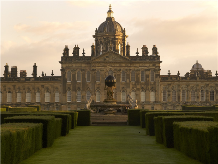Castle Howard
Overview
This option will provide an opportunity for cumulative research and sustained reflection on a single place. Located within easy distance of York, Castle Howard was created at the beginning of the eighteenth century by Charles Howard, 3rd Earl of Carlisle. The estate is famous not only for the house – which is one of the most elaborate and sophisticated domestic buildings in early modern Europe – but also for the wider landscape setting, which, with its remarkable assemblage of lawn, water, woodland and architecture, played a formative role in the development of the so-called ‘picturesque’. Castle Howard has been extensively written about over many decades, but it remains an elusive and mysterious place, as anyone who has pondered the magnificence of the house or experienced the intensity of its landscape effects will testify.
This course, then, will look afresh at the totality of Castle Howard and encourage new ways of thinking about it. Firstly, we will look afresh at the extant primary sources, including architectural drawings, estate maps, building accounts, historic inventories, and other manuscript sources, and, in doing so, provide you with a rigorous training in the skills and techniques of historical research (all applicable to employment in the heritage sector). Secondly, we will situate Castle Howard in relation to other houses and landscapes, in the UK and beyond, providing you with a broader understanding of houses and gardens in the period. Thirdly, we will explore Castle Howard in relation to a number of key concepts, including the importance of place and the function of history in early modern culture. Why was land ownership so important to the upper classes, and how was this articulated at Castle Howard? Similarly, how did notions of past, present and future inform aristocratic identity, and how did these understandings intersect with the deployment of architectural form and style. In addressing these themes, we will question some of the key presumptions of architectural historiography – that style, for example, equates to history – and we will draw upon new methodological approaches to the study of place and time.
Castle Howard is easily accessible from York. We will make regular visits to the estate, and we will be given privileged access to the house, the landscape buildings, and the collections. There will also be opportunities to meet with the curatorial staff, and to gain insights into their responsibilities and duties.

Module information
- Module title
Castle Howard- Module number
HOA00073M- Convenor
Anthony Geraghty
For postgraduates
